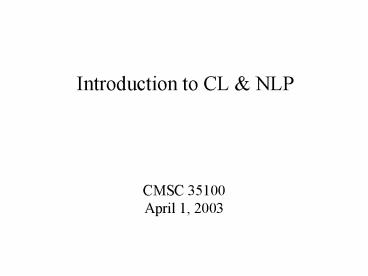Introduction to CL - PowerPoint PPT Presentation
1 / 20
Title:
Introduction to CL
Description:
Language understanding, Question-answering, Information extraction, Speech ... Colloquial, fast, slow, accented, context. Morphology ... – PowerPoint PPT presentation
Number of Views:48
Avg rating:3.0/5.0
Title: Introduction to CL
1
Introduction to CL NLP
- CMSC 35100
- April 1, 2003
2
Speech and Language Processing
- Language applications
- Language understanding, Question-answering,
Information extraction, Speech recognition,
Machine Translation,... - Computational Linguistics
- Modeling language structure
- Modeling human use of language
- What does it mean to know a language?
3
Models and Methods fromMany Fields
- LinguisticsMorphology, phonology, syntax,
semantics,.. - PsychologyReasoning, mental representations
- Formal logic
- Philosophy (of language)
- Theory of Computation Automata,..
- Artificial Intelligence Search, Reasoning,
Knowledge representation, Machine learning,
Pattern matching - Probability..
4
Balancing Act
- Competitive integrative approaches
- Symbolic vs Stochastic
- Early approaches 40's 50's
- Formal language theory (Chomsky, Backus)
- Automata theory
- Probabilistic techniques (Shannon)
- Noisy channel model
- Decoding
5
Two Paths '50-'83
- Symbolic
- Formal language theory (Chomsky, Harris)
- Logic-based systems (Kaplan,Kay)
- Lexical functional grammar, feature systems
- Toy symbolic NLU systems (Winograd, Woods,)
- Blocks world, Lunar, ..
- Discourse modeling (Grosz, Sidner, Webber)
- Reference, Topic and Task structure
- Stochastic (Jelinek, Brown, Baker, Bahl,Rabiner)
- Hidden Markov Models for speech recognition
6
To the PresentEmpiricism Moore's Law
- Empiricism
- Finite State methods (KaplanKay, Church)
- Morphology, Syntax, .
- Probabilistic approaches (Jelinek,
Perreira,Charniak) - Tagging, syntax, parsing, discourse,...
- Moore's Law
- Data-driven (and probabilistic) techniques demand
processor speed, disk space, memory!!
7
Language Intelligence
- Turing Test (1949) Operationalize intelligence
- Two contestants human, computer
- Judge humans
- Test Interact via text questions
- Questions Which is human???
- Crucially requires language use and understanding
8
Limitations of the TuringTest
- ELIZA (Weizenbaum 1966)
- Simulates Rogerian therapist
- User You are like my father in some ways
- ELIZA WHAT RESEMBLANCE DO YOU SEE
- User You are not very aggressive
- ELIZA WHAT MAKES YOU THINK I AM NOT
AGGRESSIVE... - Passes the Turing Test!! (sort of)
- You can fool some of the people....
- Simple pattern matching technique
- Perceived by (some) judges as intelligent
9
Real Language Understanding
- Requires more than just pattern matching
- But what?,
- 2001
- Dave Open the pod bay doors, HAL.
- HAL I'm sorry, Dave. I'm afraid I can't do that.
10
Phonetics and Phonology
- Convert an acoustic sequence to word sequence
- Need to know
- Phonemes Sound inventory for a language
- Vocabulary Word inventory pronunciations
- Pronunciation variation
- Colloquial, fast, slow, accented, context
11
Morphology
- Recognitize and produce variations in word forms
- (E.g.) Inflectional morphology
- e.g. Singular vs plural verb person/tense
- Door sg door
- Door plural doors
- Be 1st person, sg, present am
12
Syntax
- Order and group words together in sentence
- Open the pod bay doors
- Vs
- Pod the open doors bay
13
Semantics
- Understand word meanings and combine meanings in
larger units - Lexical semantics
- Bay partially enclosed body of water storage
area - Compositional sematics
- pod bay doors
- Doors allowing access to bay where pods are kept
14
Discourse Pragmatics
- Interpret utterances in context
- Resolve references
- I'm afraid I can't do that
- that open the pod bay doors
- Speech act interpretation
- Open the pod bay doors
- Command
15
Language Processing Pipeline
speech
text
16
AmbiguityLanguage Processing Components
- I made her duck
- Means....
- I caused her to duck down
- I made the (carved) duck she has
- I cooked duck for her
- I cooked the duck she owned
- I magically turned her into a duck
17
Part-of-Speech Tagging
- Ambiguity
- Her pronoun vs possessive adjective
- Duck verb vs noun
18
Word Sense Disambiguation
- Ambiguity
- Make cook
- Vs
- Make carve
19
Syntactic Disambiguation
- I made her duck.
S
S NP VP NP
VP PRON V NP PRON V NP NP
Poss N PRON N I
made her duck I made her duck
20
Resources forNLP Systems
- Dictionary
- Morphology and Spelling Rules
- Grammar Rules
- Semantic Interpretation Rules
- Discourse Interpretation
- Natural Language processing involves (1) learning
or - fashioning the rules for each component, (2)
embedding the rules in the relevant automaton,
(3) and using the automaton to efficiently
process the input .































